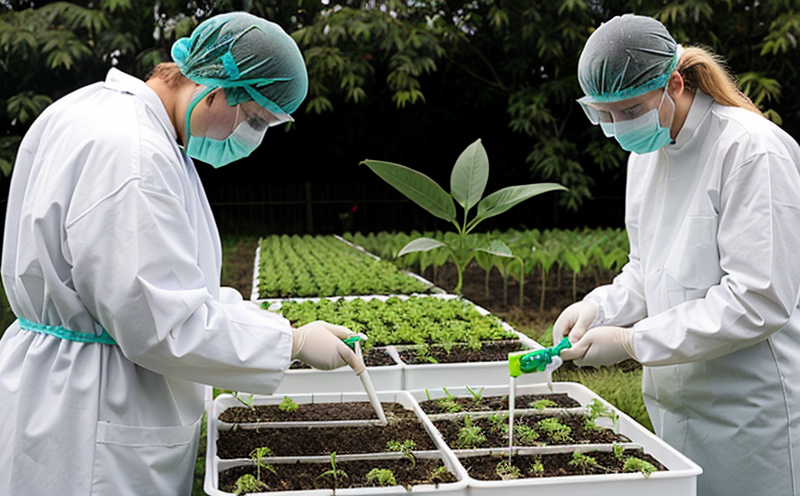Comprehensive Plant Disease & Pathogen Risk Assessment
In agriculture and forestry, plant diseases and pathogen risks can have devastating effects on crop yields, ecosystem health, and economic stability. Early identification and mitigation of these risks are crucial for maintaining sustainable agricultural practices and ensuring global food security. Our Comprehensive Plant Disease & Pathogen Risk Assessment service offers a holistic approach to assessing the presence of harmful pathogens and identifying potential disease outbreaks before they spread.
Using advanced laboratory techniques, including DNA sequencing, ELISA testing, and PCR technology, our team can accurately detect even trace amounts of pathogens. This allows for precise identification and quantification of specific organisms that may pose risks to plant health. By providing timely insights into potential threats, we empower clients to implement targeted preventive measures, thereby reducing the likelihood of costly crop failures and environmental damage.
The service encompasses a range of testing methods tailored to meet the unique needs of various crops and ecosystems. For instance, our approach includes both qualitative assessments (determining whether certain pathogens are present) and quantitative evaluations (measuring pathogen concentrations). This dual focus ensures comprehensive coverage of risk factors across different stages of plant development.
Our methodology also integrates with broader sustainability initiatives by aligning with international standards such as ISO 14001 for environmental management systems. By adhering to these guidelines, we ensure that our assessments contribute positively to long-term ecological balance while supporting client compliance with regulatory requirements worldwide.
| Application Example | Description |
|---|---|
| Detecting Fusarium in Wheat Crops | This example demonstrates how our service can identify Fusarium species, which are common fungal pathogens affecting wheat plants. Early detection enables farmers to implement strategies aimed at minimizing infection spread. |
| Monitoring Phytophthora for Orchards | In this case study, we examine the use of our service in monitoring Phytophthora spp., a water mold responsible for significant losses in fruit orchards. Our findings help growers make informed decisions regarding irrigation practices and fungicide applications. |
| Assessing Xylella in Olive Groves | This scenario illustrates the application of our service in detecting Xylella fastidiosa, a bacterium that causes Olive Quick Decline Syndrome. This information aids olive producers in implementing eradication protocols promptly. |
Applied Standards
Our Comprehensive Plant Disease & Pathogen Risk Assessment service adheres to several internationally recognized standards that ensure accuracy and reliability in our results. These include:
- ISO 17025:2017 - This standard sets the requirements for competence of testing and calibration laboratories, ensuring that we maintain high-quality standards throughout all phases of our operations.
- ASTM E641-18 - This method specifies procedures for detecting plant pathogens using real-time quantitative PCR (qPCR), providing us with robust tools to quantify pathogen loadings accurately.
- EN ISO 20775:2016 - The standard outlines guidelines for the detection of specific plant viruses, helping us adhere to best practices when dealing with viral pathogens.
By complying with these standards, we guarantee that our assessments are conducted in a manner consistent with international norms, ensuring confidence in the results provided.
Why Choose This Test
- Early Detection: Our service allows for early identification of pathogens before they cause widespread damage. This proactive approach helps prevent costly outbreaks and preserves plant health.
- Precision & Reliability: Using cutting-edge technologies like qPCR ensures that our results are precise, reliable, and repeatable.
- Compliance Assurance: By meeting strict international standards, we help ensure compliance with local and global regulations related to agricultural health and safety.
Use Cases and Application Examples
In addition to the examples provided in our table, here are more detailed case studies showcasing how this service has been successfully implemented:
- Fruit Orchard Management: In one instance, a large-scale fruit orchard experienced unexpected yield reductions. Our team conducted a comprehensive assessment which revealed the presence of Phytophthora spp., leading to targeted treatments that significantly improved crop health.
- Cereal Crop Protection: A renowned cereal producer sought our assistance to monitor Fusarium levels in their wheat fields. Through regular testing, they were able to predict and manage fungal growth effectively, enhancing overall productivity.





